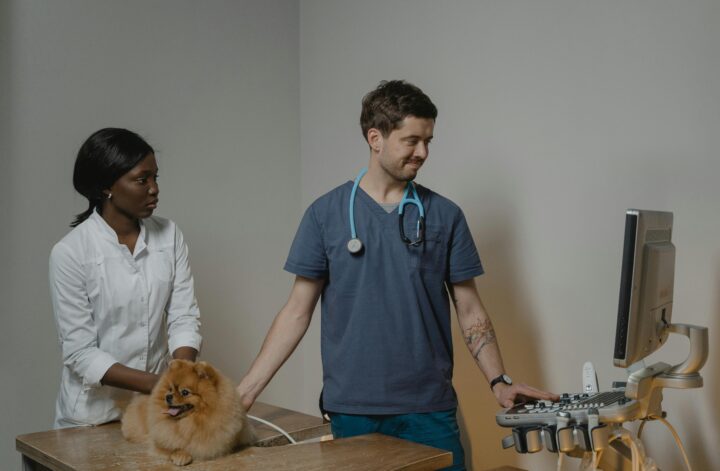Have you ever wondered how vets figure out what’s going on inside your pet without opening them up? It’s not just magic or guesswork – sometimes, it’s thanks to an ultrasound.
Ultrasounds are an incredible tool in veterinary care. They allow vets to see inside your pet’s body in real time, making it easier to find out what’s wrong or confirm that everything’s just fine. But how do you know when your furry friend might actually need one?
What Exactly Is an Ultrasound?
A vet ultrasound uses sound waves to create images of what’s happening inside the body. It’s completely non-invasive and doesn’t hurt your pet at all. Vets use a small handheld device called a probe that glides over your pet’s skin. The images it captures show organs, blood flow, and even tiny abnormalities that other tests, like X-rays, might miss. It’s a safe, quick, and reliable way to get a closer look without surgery.
Common Reasons Vets Recommend an Ultrasound
There are a handful of main reasons your vet might suggest an ultrasound. Some are routine. Others are a little more urgent.
Here are some of the most common situations where an ultrasound is needed:
Abnormal blood tests – If a blood test shows odd liver enzymes, kidney issues, or signs of infection, an ultrasound helps locate the problem.
Vomiting or diarrhoea that won’t stop – Persistent digestive issues could mean anything from a blockage to organ problems.
Unexplained weight loss – If your pet is shedding kilos without any diet change, an ultrasound can help find hidden causes like tumours or gastrointestinal disease.
Suspected tumours or masses – When your vet feels something unusual during an exam, an ultrasound helps determine its size, location, and whether it might be affecting other organs.
Urinary problems – Struggling to urinate, blood in the urine, or frequent accidents might prompt an ultrasound to check the bladder and kidneys.
Pregnancy monitoring – Ultrasounds can confirm pregnancy and monitor the health of unborn puppies or kittens.
Heart disease concerns – Sometimes a special type of ultrasound called an echocardiogram is used to see the heart in action.
Signs Your Pet Might Need an Ultrasound
Sometimes, it’s obvious something isn’t right. Other times, the signs are a little more subtle. Knowing what to watch for can help you catch problems early.
Look out for:
Persistent vomiting or diarrhoea
Swollen abdomen
Lethargy or lack of appetite
Pain when touched around the belly
Strange breathing patterns
Difficulty urinating
Sudden weight changes
Of course, these signs don’t always mean something serious is happening. However, if you notice any of them lasting more than a day or two, it’s advisable to consult your veterinarian.
What Happens During a Pet Ultrasound?
If your vet recommends an ultrasound, there’s no need to panic. The whole process is generally quick and stress-free for your pet.
Here’s what usually happens:
First, the area where the probe will be used might need to be shaved. This helps the probe make better contact with the skin and gives clearer images.
Then, your pet will lie comfortably while the vet or technician gently moves the probe across the area of interest. A special gel is applied to help with the image quality.
Most pets stay calm during the procedure. If your pet is very anxious or needs to stay perfectly still for detailed imaging, mild sedation may be given, but it’s not always necessary.
Once the images are captured, your vet can often give you immediate insights or might send the results to a specialist for further review, depending on what they find.
Is an Ultrasound Better Than an X-ray?
Ultrasounds and X-rays work differently, and each has its strengths.
X-rays are great for seeing bones and detecting large masses or certain lung issues. But they don’t show soft tissues very clearly. That’s where ultrasounds shine; they can pick up subtle details in organs like the liver, kidneys, spleen, and intestines.
In many cases, vets will use both tools together to get a full picture. It’s not about one being better than the other; it’s about using the right tool for the right situation.
How Much Does a Pet Ultrasound Cost?
Costs can vary depending on the size of your pet, the area being examined, and whether a specialist is needed.
On average, you might expect anywhere between a couple of hundred and several hundred dollars. It’s always a good idea to ask for a rough estimate beforehand so you know what to expect.
Keep in mind, while it’s an upfront cost, it often saves money in the long run by providing fast, accurate answers and avoiding unnecessary treatments.
Can You Prepare Your Pet for an Ultrasound?
A little preparation can sometimes help make things smoother. If your pet’s having an abdominal ultrasound, your vet might ask you to withhold food for a few hours beforehand. A full stomach can block clear views of the organs.
Make sure your pet is calm and relaxed before the visit. Bringing a familiar blanket or toy might help. And always follow any specific instructions your vet gives you ahead of time.
Trust Your Instincts (And Your Vet’s)
If your vet suggests an ultrasound, it’s not something to be scared of. It’s a smart step to get clear answers quickly.
Pets can’t tell us when something’s wrong, but ultrasounds give them a voice. They allow your vet to see issues early, treat them faster, and often give your pet a much better chance of recovery.
If you notice anything unusual with your pet or if you simply want peace of mind, having a chat with your vet is always the right move.




